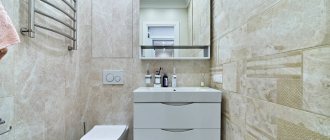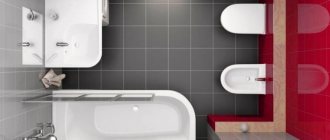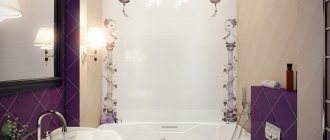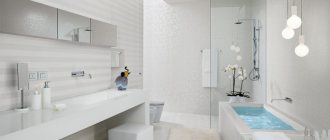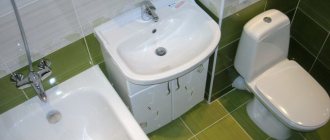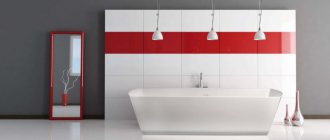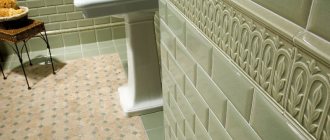Small spaces dedicated to bathrooms may very often be seen in apartments decorated in a modern design style.
To visually increase the area of the bathroom, you need to choose the right colors and materials for interior decoration.
Choosing color shades for a room is a very important undertaking, since the colors and patterns of finishing materials must be combined to create an excellent interior.
This makes the bathroom comfortable, creating a pleasant environment that allows you to relax while taking a bath. In order to expand the bathroom, you need to completely remodel the room.
This is a rather costly undertaking associated with some difficulties when carrying out internal work. The best way to expand the territory is to expand it visually with tiles.
Color
What color of tiles should I choose for a small bathroom? Here you need to remember the laws of color perception in small spaces. Designers advise using light and bright shades of primary colors, and you should not decorate the room entirely in one tone.
It is better to select material of the same color, but in two, three or four tones with a decrease. This option will allow you to cover short walls with lighter samples, and larger ones with darker ones, which will visually change the overall perception and visually expand the space.
For the ceiling, it is best to use white tiles without shades. You can also decorate the upper part of the walls, and to visually increase the height of the ceiling, use separate vertical inserts from dark elements. The same dark inserts, located horizontally, allow you to visually move the walls apart.
Any dark colors will reduce the volume, so they are not recommended for use in small rooms.
Successful color combinations
When choosing a material, you need to take into account not only the color perception of the wall decoration, but also its harmonious combination with household appliances and plumbing fixtures. The following color combinations look good in a small room:
- shades of yellow, from bright and saturated, to barely noticeable, almost white;
- blue, or even light blue color at the bottom of the wall goes well with the white top;
- Light gray tones and white color go well together on the wall;
- Lighter shades of green also look good if you place darker tones at the bottom and lighter tones at the top of the wall;
- beige products harmonize well with brown ones;
- A wall with a combination of deep pink tiles at the bottom and slightly pinkish, almost white tiles at the top will look interesting.
To zoning a room into functional zones, it is recommended to highlight each with a separate color or tone, but within the general color scheme.
To create a general interior, it is advisable to use bright accessories that are placed on the walls and plumbing.
Nice colors
There are traditional color options that are especially positively perceived by the human eye. It’s most convenient to distribute them according to the feeling created:
- Warm colors include shades of beige, yellow, sand and peach;
- shades of green, close to olive, blue or purple create a cooler atmosphere in the room;
- shades of white, pink, gray and lilac are considered neutral.
To decorate a small space, it is not recommended to mix shades of cold and warm tones. If you want to dilute a certain tone, it is better to do this with neutral colors.
In addition, grout plays an important role in bathroom design. We examined this question in this article.
Color spectrum
Choose the right tiles in cool colors for a small room. It visually expands the boundaries of the room. Looks good in a small bathroom:
- Citric. Refreshes and charges with optimism.
- White. Neutralizes a surge of emotions, calms.
- Mint. Cools and gives a feeling of freshness.
- Gray and steel. It looks strict, but stylish and cold.
- Light blue. Relieves stress, calms.
- Cold milky. A cozy, calm color from the basic series.
- Powdery. Gives a feeling of peace and tranquility.
- Cool green. Harmony, freshness, cheerfulness.
- Turquoise, etc. evoke the sea breeze.
It is advisable to take tiles from the same collection for floors and walls. You can purchase decorative borders for them. But be careful with their number in the clutch. A vertical stripe on the farthest wall looks optimal. Or if the bathtub has a high ceiling, you can lay the border just above the middle of the wall to lower the ceiling a little.
Tip: you can dilute the color of the tiles with mirror elements of the same size. Due to the glare, they will visually increase the area of the room.
Interesting: Fashionable bathroom design ideas with toilet 2020
Dimensions
For rooms of modest size, it is recommended to select materials that are also small in size. Large items on the wall will look heavy; in addition, rare seams will stand out clearly and disrupt the overall picture. Therefore, to decorate a small bathroom or shower area, you need to choose a small or medium tile size.
There are the following types of wall tile sizes:
100x100 mm. A good option for decorating a bathroom, but it should be noted that material of this size should be selected in light colors (white, beige, light yellow). Otherwise, dark shades will visually reduce the already small space even more.
You can also dilute a plain light wall with splashes of dark tiles that match the tone (for example, choose brown inserts for a light yellow tile).
The disadvantages of this size include the laboriousness of the installation process.
200x200 mm. As in the first case, when choosing tiles of this size, preference should be given to light colors.
It is more convenient to work with 200x200 mm tiles than with 100x100 mm tiles, but the square size does not allow you to visually raise the ceiling, unlike rectangular tiles located vertically.
200x300 and more. Rectangular tiles allow you to get the effect of raising the ceiling when they are laid vertically. This is the optimal size for decorating walls in a small room. To decorate a long and narrow room, the tiles are laid horizontally, which gives the effect of expanding the space.
Also, with low ceilings, it is recommended to arrange vertical stripes of rectangular tiles of a darker shade than the main tone of the wall, which gives the feeling of a higher space.
We determine the amount of material. Method No. 1
The first indicators are achieved by multiplying the length by the width and taken from the floor area. By analogy, the area of one tile product is calculated, and the data obtained is rounded up.
Having received two approximate numbers, divide the floor area by the area of the ceramics, and the resulting value is rounded to a larger integer. Thus, we have a certain number to which we need to add 5%, i.e. multiply by 1.05, and round the resulting result up.
For clarity, we need to calculate using an example where we take average statistical data. The initial ceiling is 2.70 m, the walls are 1.9 and 2.0 m, the door width is 0.7 m. If the conventional dimensions of the floor tiles are 35 by 35 cm, then the calculation will be as follows:
- 1.9*2.0=3.8 m2;
- 0.35*0.35=0.1225 m2;
- 3.8 m2/0.1225 m2=31 pcs.;
- 31*1.05= 32.55, which means you need about 33 tiles.
Method No. 2
The number of ceramic products that will be laid on the floor is calculated based on the length and width. To do this, you need to divide each of these floor parameters by a similar tile value. The resulting data is multiplied, after which we round it up and add 5% again. Here is an approximate calculation:
- 1.9/0.35=5.42 pcs.;
- 2.0/0.35=5.71 pcs.;
- 5.42*5.71=30.96 pcs.;
- 31*1.05=32.55, i.e. You need about 33 tiles.
Bathroom tile layout plan
Matte or glossy
Which tile to choose for a small bathroom, matte or glossy? For small rooms, it is recommended to use a glossy or mirror surface of tiles. The glare that occurs when light is reflected from a smooth surface visually increases the volume.
However, when choosing tiles with a glossy surface, you need to be prepared for more frequent cleaning - handprints and traces of dried water are clearly visible on a smooth surface.
Texture
Today, ceramics represent such a variety of products that it is not always possible to choose a single option. If you add to this the small size of the bathroom, then the task becomes much more complicated. By purchasing mirror tiles, you can count not only on excellent performance, but also on the original design of the entire room.
Mirror tiles
For a small shower, the best options are various inserts or patterns that will dilute the room without cluttering it up. These can be thematic or ethnic drawings, as well as modern images. In addition, for a small bathroom you can use a glass surface, mirror products, and complex convex elements. However, the rough surface is very difficult to use, so its choice is worth considering.
As for the glazed surface, the financial investment here will be at a level accessible to many. It is also worth noting that it practically does not need to be cleaned or washed. The simplest option for a small shower is tiles with small protrusions, glazed in two layers. This surface is easy to maintain and looks very attractive.
Related article: What is the best way to process wood?
Pattern or plain
When choosing ceramic tiles, it is important to take into account the main features of the visual perception of the pattern on it in the room:
- a small drawing or ornament on a single copy will look organic on the walls of a limited bathroom area in a small-sized “Khrushchev” building;
- a wall with a dimensional panel assembled from individual fragments will draw the focus onto itself, leaving the rest of the space in the shadow, which will visually reduce the volume of the room;
- the only exception may be narrow and long bathrooms, in which a bright three-dimensional pattern on the far end wall will help increase the space;
- plain tiles also allow you to visually expand the volume of the room, but in this case you need to take into account the advice of designers that you can only use products in light colors. Plain tiles look especially advantageous in shower stalls.
Detailed calculation: drawing up a sketch
For detailed calculations you will need a sketch of the bathroom. To compile it, you need to consider:
- what kind of tile pattern will be on the surfaces;
- places without tiles (for example, behind the bathroom);
- layout option.
The most popular tile designs:
- One type of tile, without decoration.
- Vertical and horizontal stripes.
- Chaotic inserts of piece decor on a tiled background.
- Using a ready-made panel.
- Breaking the walls into color blocks (for example, the top is one shade, the bottom is another).
Places that can be missed when laying tiles:
- behind the bathroom;
- for furniture;
- behind the mirrors. Especially if you are planning only a mirror sheet, which is usually glued to an uncoated surface.
Laying scheme
The visual perception of the bathroom space depends not only on the type of tile, its color or texture, but also on the method of its installation. Correct application of the laws of design will create the effect of spaciousness, even in a small area:
- traditional installation method without crossing seams. Laying is carried out at right angles without displacement of elements. This option is perfect for installing tiles of various colors in a small room;
- if it was decided to choose a single-color material for the bathroom, designers recommend laying it offset along the horizontal seam by half of the tile;
- Diagonal laying will help increase the volume of a small room, but to install such a finish you will need an experienced craftsman, and besides, after completing such work there are a lot of tile scraps left.
For the traditional direct installation method, you should purchase rectangular tiles and place them vertically. If the room is long and narrow, it is better to lay such tiles horizontally.
Video instruction
The best posts
- Do-it-yourself piglets from plastic bottles for the garden
- Spring interior details: 30 simple ways to decorate your home for spring
- DIY tennis table drawings and diagrams
- How to cash doors yourself
- What types of knives are there for cutting linoleum?
- Knit socks: patterns with videos and photos for easy and quick knitting of original socks
- DIY beaded flowers: diagrams of trees and flowers with a master class, photos and videos
- Combining wallpaper in the interior: in the living room (hall), kitchen, hallway
Other recommendations for selection
Before choosing tiles for a small bathroom, owners need to understand the classification of this material and the features of each type.
There are two main classes of ceramic wall tiles:
- First. Intended for finishing surfaces in rooms with little traffic, which exactly meets the requirements of a small-sized bath.
- Second. In this case, the requirements for abrasion of the material surface are higher than those of the first class. Such tiles are laid in spacious rooms with high traffic, but it should be taken into account that special household chemicals should be used to clean such products.
Other categories of ceramic tiles are used in other rooms and are not intended for installation in bathrooms or bathrooms combined with a toilet.
For laying on the floor, a special type of tile is used, which is able to withstand increased loads and not lose its qualities under heavy traffic. Ceramic tiles intended for walls cannot be laid on the floor.
Types of tiles for the bathroom
It is customary to divide bathroom tiles into wall and floor tiles. Each of them, in turn, is divided into certain types. Wall tiles come in:
- Mosaic. Consists of glass or porcelain stoneware. This cladding is considered durable and environmentally friendly. It has a wide range and is distinguished by patterns and geometric shapes.
- Large format porcelain tiles. It is famous for its strength and sufficient thickness. It does not crack during installation and is easy to clean after installation work. Most often it has a glossy finish, and can be textured.
- Tile. It is considered the most popular material for wall decoration. It is famous for its unlimited assortment, different textures and colors.
Dark bathroom with white fixtures Source snabdim.by
Imitation stone laying and white gloss Source stimtalux.com
White bathroom with ivory floor tiles Source classicsvet.ru
Bathroom floor tiles come in several types:
- Metlakhskaya. It is characterized by increased strength, as it undergoes several degrees of firing. The material is wear-resistant and practical.
- Clinker room. Creative cladding for bath floors. When wet, it does not slip and leaves no dirty marks on it. Easy to care for.
Combination of tiles of contrasting tones on one surface Source fontann.by
- Glazed tiles. It is distinguished by its brightness and long-lasting shine. The protective layer of the coating does not wear off over time and is resistant to falls, provided it is laid correctly.
- Pressed. No less popular floor tiles. Lay out according to the specified ornament. Fits into modern and classic style.
- No enamel. Average thickness, lack of catchy patterns - this is the feature of this material. The structure is not slippery, quite durable.
Bathroom tile options can suit different styles and standards. Therefore, it is also worth focusing on the types of coatings that are relevant at the time of repair.
Combination of different shapes and types of tiles Source keramogranit-centr.ru
Bright carrot-colored tiles with a checkerboard pattern Source bergfex.at
Shades of beige in the interior of the bathroom Source opora-stroy.ru
